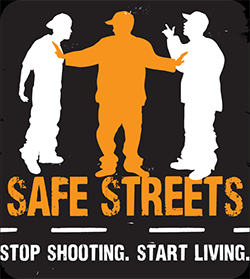Safe Streets
Since 2007, Safe Streets has been Baltimore’s flagship gun violence reduction program. Founded in 2000 by epidemiologist Dr. Gary Slutkin, Cure Violence is a public health approach that uses trusted messengers in the community to interrupt the transmission of violence. Violence interrupters spread anti-violence messages and encourage positive changes in individual behavior as well as community norms around violence. In 2007, the Cure Violence model pioneered in Chicago came to McElderry Park in East Baltimore. In 2021, Safe Streets will be adding its tenth site: Belvedere.
Safe Streets is starting an intensive internal evaluation to identify ways to improve the levels of service and outcomes provided by the ten sites. Using state funds, MONSE has contracted with Dr. Joseph Richardson, Acting Chair of the African-American Studies Department at the University of Maryland, and Dr. Daniel Webster, Director of the Center for Gun Violence Prevention and Policy at Johns Hopkins Bloomberg School of Public Health, to also evaluate Safe Streets and recommend steps for updating the model and integrating an improved Safe Streets into an ecosystem of care to address violence in our communities.
Our Partners Who Administer Safe Streets Sites
Who does it serve?
Safe Streets serves the residents of 10 target areas across Baltimore City, totaling 2.6 square miles.
How have Safe Streets contributed to crime reduction?
Past evaluations of the program from Johns Hopkins have found that Safe Streets sites are associated with decreases in fatal and nonfatal shootings, both in the sites' target areas and the area immediately surrounding the sites. In 2020, Safe Streets sites mediated over 2,300 conflicts. In June 2021, the Cherry Hill site celebrated over one year without a homicide in their target area.
Additional information about the program and evaluations can be found here:
- Evaluation of Baltimore’s Safe Streets Program: Effects on Attitudes, Participants’ Experiences, and Gun Violence
- Changes in Attitudes toward Guns and Shootings following Implementation of the Baltimore Safe Streets Intervention
- Safe Streets celebrates a year with no homicides in the South Baltimore area they serve, with hope for the rest of the city
- Using synthetic control methodology to estimate effects of a Cure Violence intervention in Baltimore, Maryland
Safe Streets Mediations
January 1, 2021 - June 28, 2021
Belair-Edison -104 |
|
Belvedere -49 |
|
Brooklyn -177 |
|
Cherry Hill -196 |
|
McElderry Park -107 |
|
Franklin Square -114 |
|
Park Heights -54 |
|
Penn-North -127 |
|
Sandtown -110 |
|
Woodbourne -66 |
|
Total –1,104 |
How are communities responding to these programs?
A core piece of Safe Streets' model is community mobilization. Sites host events and conduct daily outreach to share information, build trust with community members, and spread the Safe Streets message via credible messengers. Safe Streets sites are regarded as trusted community hubs to access resources and conflict mediation services. In 2020, Safe Streets sites hosted 451 community mobilization events with 58,000+ total attendance.
We are always looking for help from the community to
help us co-produce public safety.
How can you get involved?
Community members can volunteer at any of our Safe Streets sites during community events. If there are individuals who are interested in volunteering long-term, we could use support in the following areas:
- GED preparation;
- professional development programming and;
- connections to life-sustaining resources.
If you are interested in volunteering, please email us.
Follow MONSE
